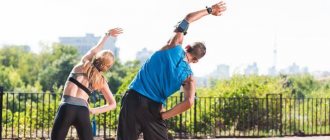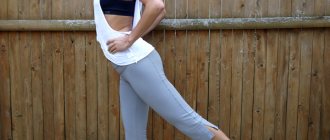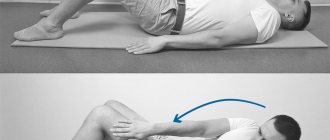Warm-up before training at home for girls: what it consists of
A good warm-up lasts at least 5-10 minutes. In this case, your pulse should reach 130-160 beats. If at the end of the exercises you feel warmth throughout your body and sweating, then the warm-up was a success. Now let's look at the warm-up plan:
- General warming up of muscles . You can start warming up with simple steps in place and moving your arms back and forth. This usually takes 1 minute .
- Joint gymnastics . Usually includes exercises such as rotations with the legs, pelvis, arms, and head - they stimulate the production of joint lubrication, making muscles and tendons more pliable and elastic. 2-3 minutes on joint gymnastics .
- Dynamic stretching . Designed to improve blood circulation in muscles. Its essence comes down to using the maximum amplitude of muscle movement to its natural limit. It usually involves swinging movements of the arms and legs. Dynamic stretching takes about 2-3 minutes .
- Cardio warm-up . Active exercises will help us warm up the body even more and get closer to the training itself. Cardio warm-up usually takes about 2-3 minutes . At the end, you should do a short cool-down to restore your breathing (you can just walk in place for 1 minute as at the beginning).
Proper three-step warm-up
How to do a warm-up, properly warm up your muscles and not get tired before the main workout begins? Let's take it in order.
Types of warm-ups
We can put it another way and replace “types” with stages. Because first, a general warm-up is done, and then, as the workout progresses, a warm-up is done for all muscle groups that will be loaded.
A general warm-up includes cardio and joint exercise. And warming up for specific muscle groups means working without weights or with light weights before specific exercises.
Let us now clarify how to warm up correctly and what set of exercises can be used for warming up.
Cardio - the first stage
A proper pre-workout warm-up begins with cardio.
You need to devote 5 to 20 minutes to running, an exercise bike, or an elliptical machine. You can combine exercise machines with jumping rope or other high-intensity cardio exercises.
- Fitness warm-up before weight training should be minimally energy-intensive. That is, the intense cardio part should be completed in 5–7 minutes.
- But if your goal is to lose weight, you need to run or jump longer - at least 20 minutes.
So, your pulse has risen, blood circulation has activated, the blood quickly carries oxygen and other necessary substances throughout the body.
Next, the question arises of how to warm up the muscles and joints to reduce the likelihood of injury. Let's look at the basic exercises for warming up before training.
Joints - second stage
Circular movements with different parts of the body help warm up your joints before training:
- Gently rotate your head. First, make 10 circular movements clockwise, then the same number counterclockwise. With each movement, try to increase the diameter of the circle being described.
- Pull your chin towards your chest, tilt your head as far as possible to the right and left. Repeat this movement several times.
- Place your fingers on your shoulder joints and roll your shoulders. Do these rotational movements with your arms in both directions 10 times each. Circular movements are made simultaneously with both arms bent at the elbows.
- Now you need to describe the circle several times with one and the other hand, turning your arm at the elbow.
- Then we do the same, rotating the hands at the wrists. Clench and unclench your fingers several times.
- Next, we make circular movements with the upper part of the body while standing on our feet.
- We fix the body and make circular movements with our hips, placing our hands on the belt.
- Now you can swing your legs forward and backward 10 times or squat 10 times at a pace.
- Raise your knee so that your thigh is parallel to the floor, and point your toes down. You need to draw a circle with your toe above the floor using movement in the knee joint.
- Place your toe on the floor and make rotational movements with your ankle.
Thus, we worked through all the joints sequentially from top to bottom.
There are other exercises to warm up your joints before exercise. They are done in exactly the same way, but your task will be to draw the number 8 instead of a circle. This warm-up is used in various schools of hand-to-hand combat. The effectiveness of this warm-up scheme lies in the fact that such a trajectory of movement warms up the joint much better than just a circular one.
Indeed, if you analyze this diagram, then in one exercise you perform several simple movements at once. For example, when tracing the number 8 with your head, you move your head forward, backward, right, and left. There are also circular trajectories.
How to conduct such a warm-up is exactly the same as a regular circular one. This is a very interesting way to prepare the body for training.
Warm-up at home is carried out in the same two ways: in a circle and in the figure 8.
Warm-up before training can take place in the form of outdoor active games, if we are talking about a children's sports section.
In martial arts schools, they conduct a warm-up to strengthen the body's strength and coordination resources. Such preparation allows you to warm up your muscles before training and prepare your body for good coordination.
How to make training safe? Do a basic warm-up!
A selection of videos for warming up before training at home for girls
Simple program
This is the most common pre-workout warm-up that only takes 5 minutes. Many of the exercises are well known to you from school. The complex includes exercises for the arms and legs, running in place, jumping, and movements of all joints. This program allows you to raise your body temperature, supply your muscles with oxygen and improve your metabolism.
Stretching program
This program takes about 10 minutes and warms up all parts of the body. Particular attention is paid to dynamic stretching, which improves blood circulation in the muscles and maximally prepares the body for the upcoming workout. The program is suitable for beginners, although some of the exercises may be difficult for them.
Active program
If you are going to do an active fat-burning workout, then the warm-up should be appropriate. This program includes a lot of cardio exercises that will quickly get your heart racing. The program takes 10 minutes and is more suitable for those who are already prepared.
Conclusion
Warm-up before training at home for girls should be done at an average pace. If you are too sluggish, you will not be able to warm up your muscles well. And if you are too active, you risk damaging yourself. A good warm-up will tone you up and prepare you mentally and physically for exercise. We hope that this material was useful to you. Bookmark our article with exercises and, of course, share it on social networks.
Why do you need a warm-up?
- Firstly , a warm-up is a warm-up and stretching of all joints and muscles before intense training, and therefore a lower risk of injury and no pain after exercise.
- Secondly , bringing the pulse to the desired, “effective” pace: up to 90-100 beats per minute;
- Thirdly , after 10-15 workouts, the level of adrenaline in the blood increases and overall metabolism accelerates;
- Fourthly , a few simple exercises before the main complex help to “tune in” to the lesson.
Therefore, no matter what your main pastime in the gym is: whether you do boxing, step aerobics, CrossFit or lifting iron - always start your workout with a warm-up, and you will see how your results improve.
Interesting Previously, many researchers claimed that the best time for training is from 16 to 19 hours (working hours). However, recently, to the delight of all working fitness enthusiasts, it was proven that the body can adapt to any rhythm and time of exercise.
Warm-up before training - what are its benefits?
Warm-up, as preparation for performing basic exercises, is simply necessary. What is its use? Or can it still be done?
- In the process of warming up before training, as I already said, the muscles warm up. Due to this they become more elastic. This reduces the likelihood of injury.
- The joints are also prepared to perform various types of movements.
- Blood circulation is stimulated, the cardiovascular system is prepared for stress.
- Psychologically, the body prepares for the main training and adjusts to it.
- The loads of the main complex are easier to bear after preliminary preparation.
We conclude: warming up before training will give you a surge of strength and energy. The consequence of this will be an increase in the efficiency of the main complex.
Features of classes at home
Morning exercises are within the framework of traditional physical education postulates:
- First, warm up. It helps prepare the body for further exercise. You cannot ignore it - you can get injured even when exercising without weights.
- Then the main set of exercises. They tone the muscles and give the main result.
- Hitch. The final stage in which normal heart rate is restored.
The average duration of the entire complex is 15 minutes. Morning exercises for men and women over 40 should be reduced to 10 minutes. It is better to place more emphasis on walking.
Gymnastics must be done on an empty stomach, 5 minutes after sleep. You can drink a glass of water - this will speed up blood circulation and the functioning of the gastrointestinal tract.
How to properly warm up before training
Dynamic stretching improves flexibility, regulates blood flow, reduces the risk of injury, and reduces the time it takes for muscles to recover. Simply put, the workout will be easier, and the results will be noticeable faster. This warm-up consists of 3 stages and will help you speed up your heart rate, prepare your muscles for stress and tune in to the desired rhythm.
Switch On: Activating the Nervous System (Exercises 1-3)
Even if you are mentally ready to lift as much weight as possible, your body needs a little more time. When you first enter the gym, the central nervous system, which actually controls all movements, is in “energy saving mode” (this is due to the whole day spent at the computer or in front of the TV). So first, your brain needs to signal your body to get ready for explosive activity. These coordination exercises will instantly “wake up” your nervous system, speed up your heart rate and increase your body temperature. And as a result, the muscles will respond better to the load you give during training.
Full and complete: muscle involvement (exercises 4-6)
Now that your heart is pumping at the right pace, it's time to strengthen weak and rarely used muscles: buttocks, abs, hip flexors and lower back. These stabilizer muscles regulate the position of joints during movement. By forgetting to stretch these muscles, you increase the risk of injury.
And a little more: dynamic mobility (exercises 7-9)
And at the end of the warm-up, you will increase joint mobility and flexibility of large muscle groups from crown to heels. And this is very important: if the muscles are stagnant, frozen, then training turns into a fight with oneself, and not burning calories.
Lack of warm-up - what are the consequences?
Most exercisers, as a rule, do not do a full warm-up. What are the consequences of its absence:
- Poorly warmed muscles and tendons are not prepared for stress. The result may be a sprain.
- During training, the load on the heart muscle increases. If you immediately apply a load, there is a high probability of losing consciousness from the pressure drop.
- Another problem that can happen is joint injury. When exercising without pre-warming up, the possibility of getting such an injury increases significantly.











